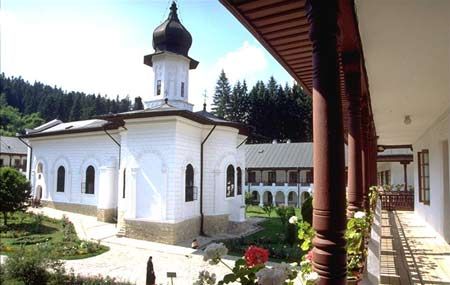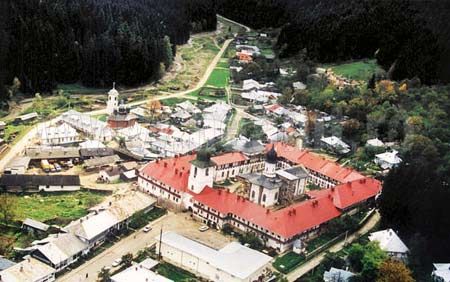This is one of the oldest and most famous monasteries in Romania, both as a place of worship, culture centre and, for art lovers, a church which was painted by Nicolae Grigorescu, a famous Romanian master, highly influential and respected, who lived in the 19th century. The Agapia Monastery is one of the most popular tourist attractions in the region, as most of the tourists never miss the opportunity of visiting it again and again. And there are also many who come this far especially to visit the monastery.

It's story actually begins sometime around the 14th century, when an onlder monastery than that we can see today was founded, not far from the curent location, only known today by the name of Old Agapia. The first hermit who lived here gave the name of the place, for he was called Agapie and came from the Neamt Monastery. The church he built here was eventually destroyed in a snow avalanche and was rebuilt nearby, only to once again be built by the end of the 15th century on the current spot. The first documentary mentioning of the monastery dates from 1437, when in a very old scroll the Agapia Monastery and the Neamt Monastery's boundaries were set.
The first stone church here, by all accounts a very impressive project for that time, was built at Agapia by Petru Rares si Elena Doamna, his wife. Still, another inscription mentions some other founders, Petru Schiopul and Ruxandra Doamna, but who could tell, in the absence of a reliable alternate source, which was the truth. Maybe the first ones completed the church, while the second only decorated or restored it. Nevertheless, due to the poor condition of the terain, the monastery was once again moved to the present location, much safer and better, today's Agapia Monastery, also named the New Agapia or the Large Agapia. And large it was, for at that time it was one of the largest monasteries in the region and even, it seems, in the country.

This new monastery was built in October 1642 - September 1644 by the brother of Vasile Lupu, Gavril Coci, together with his wife Liliana, and the holy place was consecrated in September 1647, while the workers kept on building the lodgings for the monks and the bell-tower, all made in massive stone, as the monastery ended up looking like a fortress. Sturdy and strong, worthy of standing the test of time, the Agapia Monastery quickly became a very special place in the Orthodox world, and it wasn't long before it was turned into a monastery for nuns, at the beginning of the 19th century.
So a new chapter began in the lengthy history of the monastery, and in 1821 expensive and complicated procedures of restoring the complex began, and in 1858 - 1862 the original structure was further expanded and once again decorated. Also, during those important years, the church of the monastery was completely painted and decorated by a young painter in his 20s, named Nicolae Grigorescu, who would later be recognised as one of the greatest Romanian painters ever. Back then it was a large, huge even project for him, but the painter provided a sense of colour and understanding of the norms of sacred art hard to match. The end result ? One of the most beautifully decorated churches in the country and a testimony to Grigorescu's talent.

































